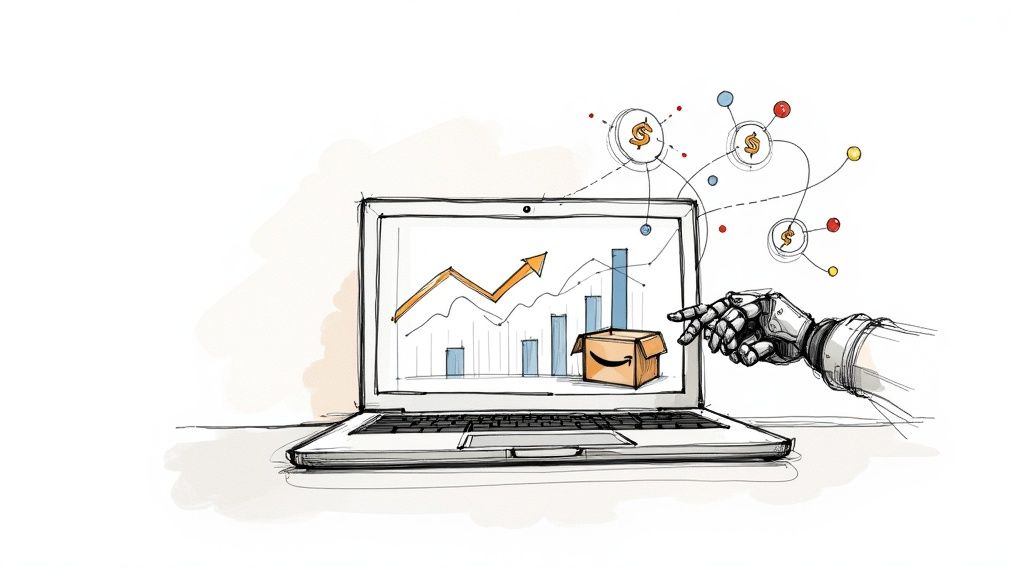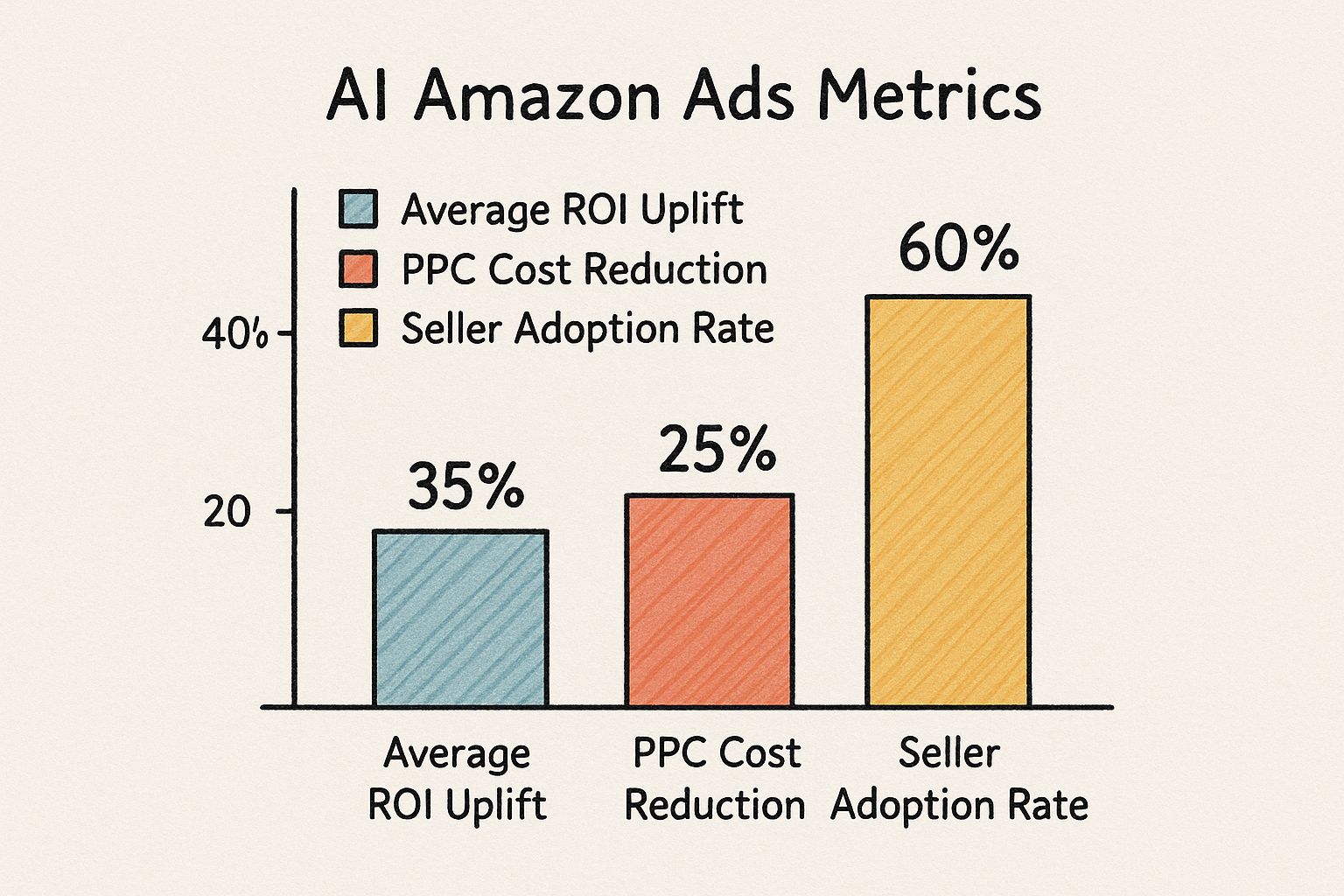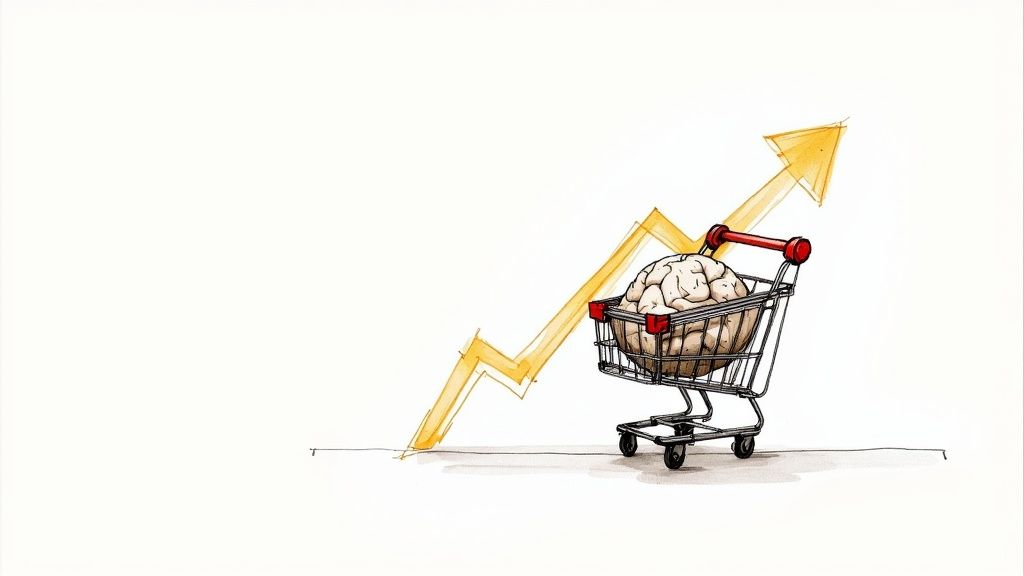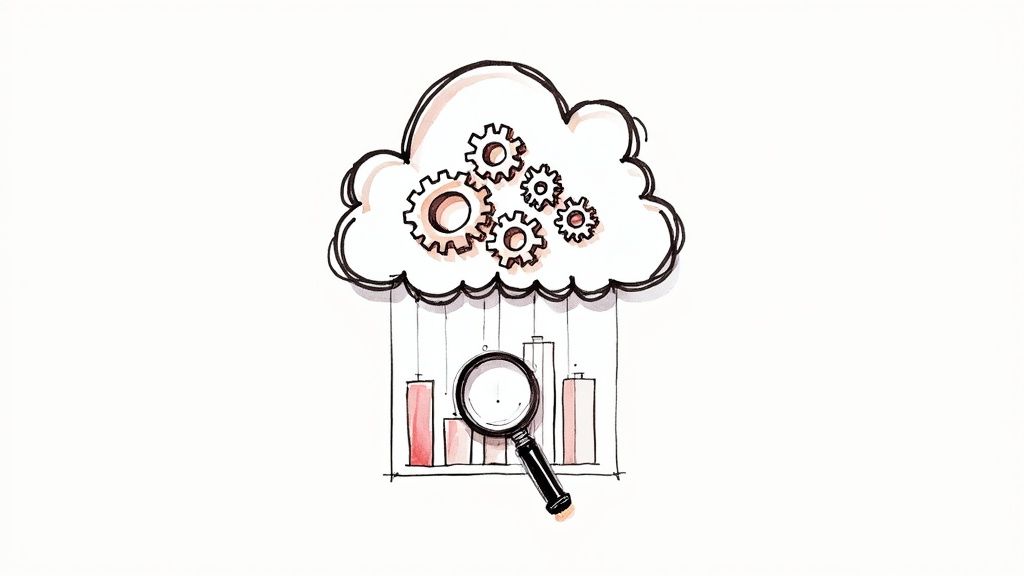AI Amazon Ads Optimization to Boost Your ROI

📊 Part of Our AI Marketing Series: This article focuses on Amazon Ads optimization specifically. For the complete marketing workflow that includes audience research, social media, email campaigns, and multi-platform advertising, see our comprehensive Complete Guide to AI Book Marketing.
Optimizing your Amazon ads with AI isn't some futuristic luxury anymore—it's a must-have. We're talking about using intelligent software to automate and sharpen your ad campaigns. This moves you away from hunches and manual tweaks, letting you make decisions based on cold, hard data. The goal? Run a tighter ship, improve your efficiency, and get a much better return on your ad spend in what's become an incredibly crowded marketplace.
Why You Can't Afford to Ignore AI for Amazon Ads
Welcome to the new reality of Amazon advertising. If you're still adjusting campaigns by hand, you're essentially showing up to a high-tech shootout with a pocket knife. The game has changed, largely due to the transformative power of AI-powered advertising. For anyone selling on Amazon, this isn't just another passing trend; it's a fundamental shift in how you win.
The biggest push is coming from the sheer increase in competition and costs. In 2025, the average cost-per-click (CPC) has climbed to $0.98, a leap of over 10% from last year. And if you're in a tough category like electronics? You can expect CPCs to sail right past $1.50.
This image drives the point home, showing just how much AI adoption is moving the needle on critical seller metrics.

The numbers don't lie. Sellers who have leaned into AI are seeing real, measurable gains in their ROI and a noticeable drop in wasted spend. It’s a clear signal that this has become a core part of any serious advertising strategy.
The Problem with Doing It All by Hand
Managing your campaigns manually means you're perpetually playing catch-up. You might log in to check your reports once a day, but an AI tool is crunching performance data every single minute. It doesn’t need sleep, it never gets distracted, and it won't miss a tiny shift in customer behavior that happens at 3 AM on a Tuesday.
Think of AI as your tireless strategic partner. It digs through mountains of data to find profitable patterns and opportunities that are frankly impossible for a person to spot. This is all about making smarter, faster, and more profitable decisions.
To put it into perspective, here's a quick comparison of the old way versus the new way.
Manual vs AI-Driven Amazon Ad Management
| Aspect | Manual Management | AI-Driven Optimization |
|---|---|---|
| Speed | Reactive; adjustments made daily or weekly. | Proactive; real-time analysis and bidding. |
| Scale | Limited to what one person can realistically handle. | Manages thousands of keywords and bids at once. |
| Data Analysis | Relies on summary reports and human interpretation. | Deep dives into granular data to find hidden trends. |
| Efficiency | High potential for wasted spend on poor keywords. | Instantly identifies and negates irrelevant terms. |
| Focus | Stuck in the weeds of spreadsheets and bid changes. | Frees you up for high-level business strategy. |
This table really highlights the core differences. The manual approach, while once the only option, is now a significant competitive disadvantage.
Just think about the practical headaches of manual management:
- Keyword Quicksand: Trying to research, test, and optimize thousands of potential keywords on your own is a recipe for burnout. It's simply not feasible.
- Stale Bids: You might set a perfect bid in the morning, but by lunchtime, competitor moves and shopper trends have already made it outdated.
- Budget Leaks: Without constant monitoring, you could easily blow your budget on irrelevant search terms for hours or even days before you notice the mistake.
This is exactly where AI-powered platforms come in. They automate the grunt work—analyzing competitor bids, adjusting for the time of day, and sniffing out negative keywords on the fly. This shift doesn't just save you time. It allows you to redirect your most valuable asset—your attention—to the things that actually grow your business, like developing new products and building a brand people love.
Choosing the Right AI Advertising Toolkit
Diving into AI-powered advertising for your Amazon business can feel like a game-changer, but first, you have to pick your tools. The market is packed with options, and it’s easy to get lost in a sea of flashy features. The key isn't to find the fanciest platform, but the one that actually fits your business needs, your budget, and how you work. Think of it as hiring a specialist for your AI Amazon ads optimization efforts.

Let's be real: a startup running on a shoestring budget has completely different needs than a major brand juggling hundreds of different products. The startup will likely get the most bang for its buck from a straightforward, affordable tool that nails the basics, like bid automation and finding new keywords. The larger brand, on the other hand, is probably looking for an enterprise-level solution with deep, granular controls, custom reporting, and the ability to plug into other marketing channels.
Core Features to Evaluate
When you're comparing different AI platforms, you have to look past the marketing fluff. What really matters are the core functions that will actually move the needle for your campaigns. A truly solid tool will excel in a few critical areas.
Here’s a quick checklist of what I always look for:
- Predictive Analytics: Can the tool give you a realistic forecast of your performance? Being able to predict your ACoS or ROAS based on historical data is a massive advantage for planning your budget.
- Automated Dayparting: Does it let you adjust bids based on the time of day or day of the week? This is low-hanging fruit—you don't want to waste money advertising at 3 AM if your customers only buy during their lunch break.
- Keyword and Negative Keyword Automation: How good is it at digging up profitable long-tail keywords while also finding and blocking the irrelevant search terms that are just eating your budget?
- Reporting and Insights: Does the dashboard give you clear, actionable insights, or just a mountain of raw data? You need a tool that explains why something is happening, not just that it happened.
This advice isn't just for typical e-commerce sellers. For authors and publishers, the same ideas apply, though the specific tools might be different. If that's your world, you might find our guide on AI book marketing tactics helpful, as it dives into platforms built specifically for the publishing industry.
Aligning Tools with Your Business Goals
Ultimately, the right tool is the one that acts as an extension of your overall strategy. If your main goal is aggressive growth and snatching up market share, you’ll want a platform with strong competitor intelligence features. You need something that can see what your rivals are bidding on and where they're leaving gaps for you to swoop in.
Your choice of an AI toolkit is a strategic decision that directly impacts your ability to scale. Select a platform that not only solves today's problems but can also grow with you as your business evolves and your advertising needs become more complex.
On the flip side, if profitability and a high ROAS are your top priorities, you should be laser-focused on tools with top-tier bid optimization algorithms and tight budget controls. These features ensure every single ad dollar is working as hard as it possibly can to protect your margins. Don't get distracted by a long list of features you'll never touch. Sometimes, a simpler tool that is exceptional at its core job is the smartest choice.
Automating Your Bids with AI Precision
Let's be honest, manual bidding on Amazon is a grind. You're constantly checking reports, nudging bids up or down, and basically reacting to what happened yesterday. It’s a reactive game, and it’s where a lot of sellers bleed money and lose their edge. This is where real AI Amazon ads optimization completely changes the playbook, turning your bidding from a constant guessing game into a proactive, data-driven strategy.

We're not just talking about simple rules like "lower the bids at night." Modern AI platforms are powered by machine learning models that actually predict the conversion probability of every single click before it happens. Think of it as having a hyper-focused analyst evaluating each shopper in real-time, right before you place your bid.
Moving Beyond Simple Rules
A person might set a broad, campaign-level rule. An AI, on the other hand, can manage thousands of micro-adjustments across your entire account at the same time. It’s crunching a ton of variables for every single ad auction, something no human or team could ever realistically do.
What kind of variables are we talking about?
- Ad Placement: The AI knows a top-of-search spot converts differently than a placement on a competitor's product page, and it bids accordingly.
- Time of Day: It goes beyond simple dayparting and analyzes conversion rate dips and spikes by the hour, letting you capitalize on those prime buying moments.
- Audience Segment: The system can look at shopper data—like past purchases or recent browsing—to bid more aggressively on audiences that are more likely to convert.
- Device Type: It gets that someone scrolling on their phone behaves differently from someone shopping on a desktop, and it adjusts the bids to match that context.
This granular approach is what makes all the difference. AI-powered bidding uses a firehose of real-time data—impressions, clicks, conversion stats, and even external market signals—to set bids on the fly. This level of automation is geared toward maximizing your Return on Ad Spend (ROAS) by spotting trends and competitor shifts far faster than you could on your own. You can get a deeper look into these advanced AI bidding strategies on Eva.guru.
Setting Up Your First AI Bidding Campaign
I get it—handing the keys over to an algorithm can feel a little nerve-wracking. The key to success, however, is remembering that you're still the pilot. The AI is a powerful engine, but you're the one who tells it where to go. Your main job is to define what a "win" actually looks like for your business.
The biggest mistake I see sellers make is giving the AI vague, fuzzy goals. You have to be specific. A clear target ACoS (Advertising Cost of Sale) or ROAS is the North Star for every single decision the algorithm makes.
For example, telling the AI to "get more sales" is practically useless. It’s too broad. A much better instruction is, "Maintain a target ACoS of 30% for Campaign A," or "Hit a minimum ROAS of 4:1 for our new product line." That clarity is non-negotiable.
The data you feed it is just as important. An AI model needs a good chunk of historical campaign data—at least a few weeks' worth is a good starting point—to learn your account's specific rhythms and patterns. Make sure that data is clean. Try to avoid making huge manual changes to campaigns right before you turn on automation, as that can pollute the data and confuse the AI during its learning phase.
Give the AI a clear target and clean data, and you offload all the tedious bid management. That frees you up to focus on what really matters: big-picture strategy.
Uncovering Profitable Keywords with AI
Winning on Amazon means getting your product in front of the right shopper at the exact right moment. That entire battle is won or lost with your keywords. Solid AI Amazon ads optimization isn't just about tweaking bids; it's about fundamentally rethinking your targeting by digging through mountains of search data to find opportunities you’d never spot on your own.
Trying to do keyword research manually is a slow, frustrating process that almost guarantees you’ll leave money on the table. You might find the obvious, high-traffic terms, but you’ll completely miss the specific, long-tail keywords that signal a shopper is ready to buy. AI tools, on the other hand, can analyze thousands of customer search term reports, peek at what your competitors are doing, and track market trends to build a complete keyword strategy.
Discovering Hidden Long-Tail Keywords
AI is fantastic at finding subtle patterns in language. It can take a broad term like "yoga mat" and connect it to dozens of highly specific, long-tail variations like "extra thick non slip yoga mat for hot yoga" or "eco friendly cork yoga mat with alignment lines." These longer phrases aren't just random words; they're used by shoppers who know exactly what they want and are much closer to making a purchase.
A person brainstorming keywords might never come up with these hyper-specific phrases. An AI, however, plucks them directly from real customer search data, tests how well they perform, and seamlessly adds them to your campaigns. This uncovers pockets of low-competition, high-conversion traffic that your rivals are probably overlooking—a huge advantage in crowded niches where broad keywords cost a fortune.
The real magic of AI in keyword research is that it eliminates guesswork. It uses hard data to find the exact language customers use right before they click "Add to Cart," giving you a direct line to their intent.
This idea of using AI to decode customer language isn't just for physical products. Authors and publishers are now using very similar tactics to market books. If that's a world you're interested in, our guide on AI keyword research for books shows how these same principles apply in a completely different industry.
Neutralizing Budget-Draining Negative Keywords
Finding the right keywords is only half the job. Just as important is getting rid of the wrong ones. Negative keywords are terms you absolutely don't want your ads showing up for, and an AI tool is your best line of defense against this kind of wasted ad spend. It tirelessly scans your search term reports for irrelevant queries that are triggering your ads and eating up your budget.
Let's say you sell premium "leather briefcases." Without careful management, your ads might pop up for people searching for "cheap canvas briefcases" or "briefcase repair." An AI tool will flag these terms because they get clicks but no sales, then automatically add them to your negative keyword list. Your budget is instantly preserved for shoppers who are actually looking for what you sell.
This automated cleanup gives you a few major wins:
- Speed: The AI finds and blocks bad keywords in hours, not the days or weeks it would take you to do it manually.
- Accuracy: It makes cold, hard, data-driven decisions, removing any emotion or guesswork.
- Efficiency: It saves you from the mind-numbing task of combing through messy search term reports yourself.
This constant, automatic refinement makes your ad spend more effective day by day, ensuring every dollar is aimed at the searches most likely to end in a sale.
Using AI for Performance Analysis and Creative Testing
All the data in the world is useless if you can't figure out what it means. This is where AI Amazon ads optimization truly shines—it transforms that overwhelming flood of performance metrics into clear, strategic moves. Performance reporting stops being a chore about what happened last week and becomes your roadmap for continuous growth.

AI-powered dashboards bring the most important insights right to the surface, saving you hours of digging through spreadsheets. Instead of drowning in numbers, you get a clean, immediate view of which campaigns are actually making you money and which are just burning through your budget.
Translating Metrics into Strategy
A smart platform does more than just flash your ACoS or ROAS on a screen; it explains why those numbers look the way they do. It connects the dots between a specific keyword, the ad creative someone saw, and whether they ultimately bought your product. When you're digging into performance, it's crucial to know what each metric really represents. You can get a much clearer picture by understanding the nuances of ROI versus ROAS.
The real objective is to get past simple reporting. A good AI tool is like having an analyst on your team, flagging underperforming ASINs, spotting keywords that are cannibalizing each other, and suggesting you shift budget to jump on new opportunities as they pop up.
This analytical firepower isn't just a niche feature anymore; it's a core part of the modern advertising toolkit. Even Amazon is leaning in, rolling out its own AI-powered creative tools and bid optimization that adjust your campaigns on the fly. Brands that embrace these insights are seeing real, measurable lifts in both engagement and conversions.
AI-Driven Creative Testing and Optimization
Winning on Amazon isn't just about bids and keywords; your ad creative has to grab attention. AI makes A/B testing your creative assets—from the main product image to the headline copy—incredibly efficient. You can finally stop guessing and start systematically testing different elements to see what actually convinces shoppers to click.
For instance, you could run tests to compare:
- A lifestyle photo versus a clean, product-on-white image.
- A headline that focuses on a technical feature versus one that sells a benefit.
- Video ads that showcase the product in different real-world scenarios.
The AI doesn’t just set up the test and walk away; it watches the results in real time. As soon as a clear winner emerges—let's say the lifestyle photo boosts your click-through rate by 15%—the system can automatically funnel more of your budget to that top-performing ad.
This concept of using AI to generate and test marketing assets is powerful and applies well beyond just e-commerce products. For authors, these same tools can be a total game-changer. For a closer look at that, check out our guide on https://manuscriptreport.com/blog/how-to-use-ai-to-market-a-book.
By automating your creative optimization, you ensure your ads are constantly evolving to be their best. It gives you a serious advantage over competitors still using a "set it and forget it" mindset.
Common Questions About AI for Amazon Ads
Jumping into AI-driven advertising always brings up a few questions. That's a good thing. Whenever you bring a new tool into your workflow, you want to know what to expect and how to handle it. Think of it less like a blind leap of faith and more like getting to know a new, highly-skilled team member.
Let's walk through some of the most common things sellers ask when they're getting started with AI Amazon ads optimization. Getting these answers straight from the beginning helps build confidence and sets you up for a much smoother, more profitable experience.
How Much Data Does an AI Tool Need to Learn?
This is usually the first question people ask, and it's a critical one. An AI model can't just start working from scratch; it needs to study your past performance to understand what "good" looks like for your specific products.
Generally, you'll need at least two to four weeks of solid, consistent campaign data for the AI to get its bearings. This isn't just an arbitrary waiting period. During this time, the algorithm is learning the unique patterns of your account, like:
- When your customers are most likely to buy (your peak conversion times).
- Which keywords actually lead to sales versus those that just eat up your budget with clicks.
- Any weekly or seasonal trends that affect your performance.
Without that history, the AI is just guessing. That's why it's a good idea to avoid making huge, sudden changes to your campaigns right before you turn on an AI tool. Let it learn from a stable foundation first, or you risk confusing it from the get-go.
Can I Still Make Manual Changes to My Campaigns?
Absolutely. In fact, you should. The point of using AI isn't to make you obsolete; it's to free you from the tedious, time-consuming work of making thousands of tiny bid adjustments every day. You're still the strategist, the one setting the overall direction.
Think of the AI as your co-pilot. It handles the moment-to-moment adjustments with incredible speed and precision, but you're the captain steering the ship.
One of the biggest mistakes I see sellers make is just "setting and forgetting" their AI tool. The technology is powerful, but it can't read your mind. Your insights are the secret ingredient.
You're the one who knows about an upcoming promotion, a potential inventory shortage, or a new product launch. The AI only knows what the data tells it. For instance, if you're gearing up for a big holiday sale, you'll want to jump in and manually increase your campaign budgets and maybe be a bit more aggressive with your target ACoS. The AI will then take your new instructions and execute them flawlessly, but the strategic decision still came from you.
What if the AI Makes a Mistake?
It happens. No system is infallible, and sometimes an AI will make a move that looks odd or even drives a poor result in the short term. Often, this is just part of its learning process—testing a new hypothesis to see what happens.
Good AI platforms have safeguards built in, but your own oversight is the best safety net. If you notice a keyword bid has suddenly shot up with no conversions to show for it, it's perfectly fine to intervene. Most tools let you set guardrails, like a maximum bid or a daily spending cap on a specific campaign, to prevent things from getting out of hand.
The best approach is to treat it as a learning opportunity. Instead of just shutting it down, try to figure out why the AI did what it did. Was it chasing a new search trend? Did a major competitor suddenly run out of stock, creating an opening? Working with the tool this way helps you refine your strategy and give the AI clearer instructions for the future.
Ready to stop guessing and start marketing your book with data-driven precision? ManuscriptReport.com turns your manuscript into a complete marketing kit in minutes, giving you everything from blurbs and keywords to ad copy and social media posts. Get your full book marketing report today!